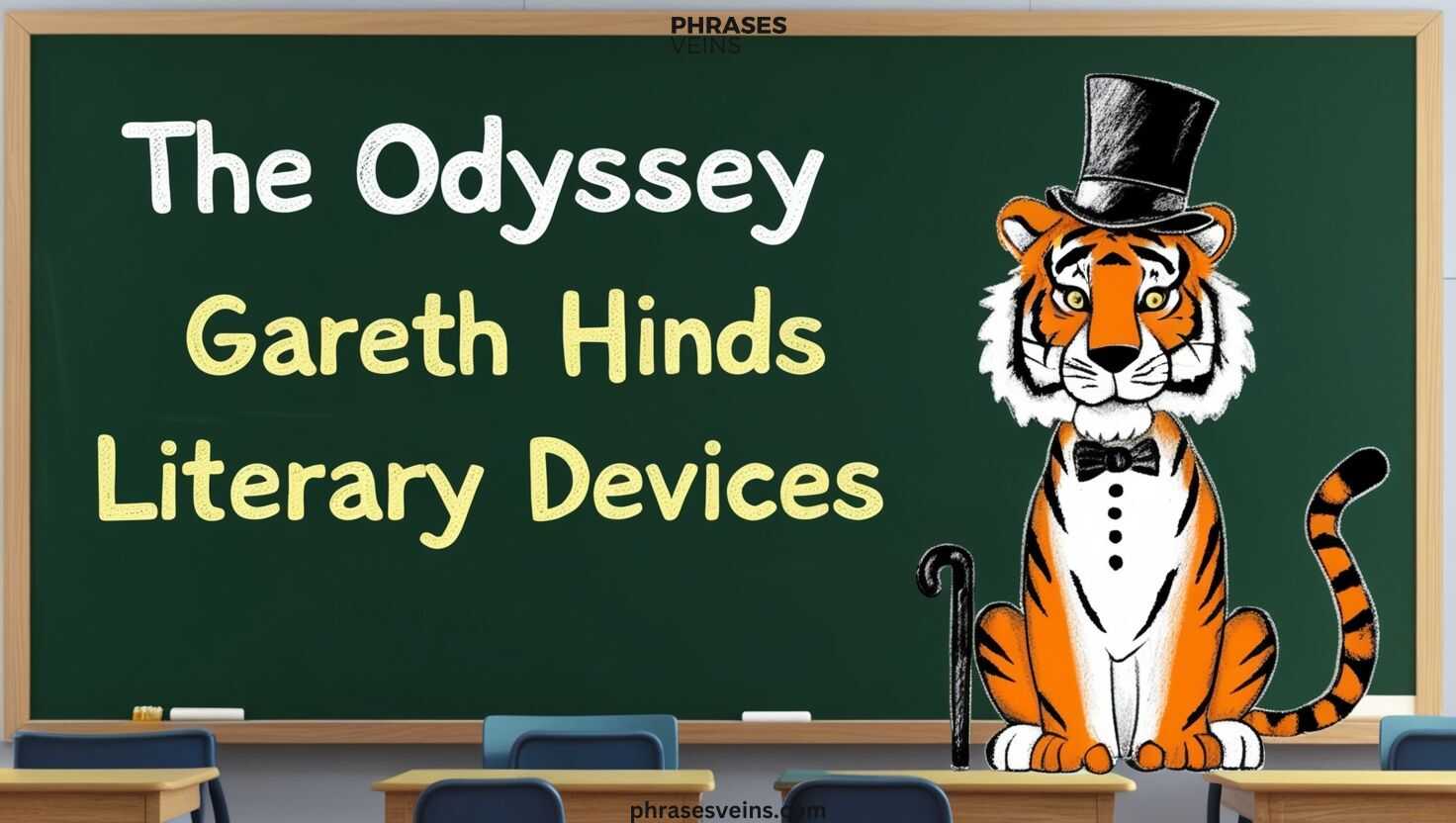Gareth Hinds’ graphic novel adaptation of Homer’s epic, The Odyssey, breathes new life into this timeless classic. By using a sequential art medium, Hinds reimagines Odysseus’ journey with vibrant visual storytelling and masterful literary devices. This article delves deep into the tools and techniques he employs to capture the essence of Homer’s The Odyssey.
The Enduring Allure of The Odyssey
Homer’s epic poem has captivated audiences for centuries. Its exploration of universal themes like heroism, fate, and perseverance continues to resonate. Gareth Hinds’ illustrated rendition brings these themes to life, making them accessible to both seasoned readers and hesitant readers alike.
- Timeless Themes:
- Heroism and resilience.
- The struggle between free will and fate.
- The power of loyalty and family.
- Impact on Modern Readers:
- Appeals to high school students.
- Aids in understanding complex literary elements.
Visual Storytelling: Art as a Literary Device
Hinds’ visual storytelling techniques enhance the narrative, making the text more engaging. His artwork provides a layer of depth beyond words.
- Key Features:
- Dynamic panel layouts guide the reader’s eye.
- Expressive characters convey emotion without dialogue.
- Benefits for Readers:
- Helps struggling readers grasp the story.
- Offers a visual interpretation of complex scenes.
Capturing the Essence of the Odyssey
Hinds skillfully translates the spirit of The Odyssey into a graphic novel format, preserving its classical integrity.
- Fidelity to Source Material:
- Stays true to Homer’s original work.
- Uses direct quotes to maintain authenticity.
- Creative Liberties:
- Adds modern touches to engage today’s audience.
- Simplifies complex scenes for clarity.
Emotive Expressions and Body Language
Hinds excels at portraying emotions through characters’ facial features and body language.
- Examples:
- Odysseus’ grief depicted in his eyes.
- Penelope’s hope shown through her posture.
- Impact:
- Connects readers to the characters’ inner struggles.
Symbolism in Hinds’ Graphic Representation
Symbolism plays a significant role in Hinds’ adaptation. His use of symbolic imagery enriches the narrative.
- Symbolic Elements:
- The sea: Represents Odysseus’ journey and trials.
- Mythological creatures: Embody challenges and fears.
- Visual Impact:
- Enhances understanding of themes.
- Creates a deeper emotional connection.
The Significance of Mythological Creatures
Mythological creatures like the Cyclops and Sirens are pivotal in The Odyssey. Hinds’ illustrations make these figures even more compelling.
- Details:
- Cyclops: Symbolizes brute force and ignorance.
- Sirens: Represent temptation and danger.
- Purpose:
- Highlights Odysseus’ resourcefulness.
- Reinforces thematic exploration.
The Power of Visual Metaphors
Hinds uses visual metaphors to add depth to the story. These metaphors help convey abstract ideas effectively.
- Examples:
- Stormy seas: Reflect inner turmoil.
- Light and shadow: Indicate moral dilemmas.
- Effect:
- Enhances the narrative’s emotional impact.
Use of Imagery and Metaphor in the Artwork
Hinds’ artwork is rich in imagery and metaphor, providing layers of meaning.
- Imagery Highlights:
- Vivid depictions of Greek landscapes.
- Detailed battle scenes.
- Metaphors:
- Olive trees: Symbolize peace and endurance.
- Broken ships: Represent lost hope.
Evocative Landscapes and Environments
The settings in Hinds’ adaptation are both visually stunning and narratively significant.
| Scene | Symbolism |
|---|---|
| Ithaca’s shores | Home and belonging |
| Calypso’s island | Temptation and stagnation |
| Trojan battlefield | Sacrifice and valor |
Metaphorical Representations of Themes
Themes in The Odyssey are explored through metaphorical representations in Hinds’ artwork.
- Examples:
- Labyrinthine paths: Symbolize life’s challenges.
- Starry skies: Represent hope and destiny.
- Outcome:
- Makes abstract concepts tangible.
READ MORE >>> Training Or Trainning: Which One Is Correct?
Characterization through Visual and Textual Techniques
Hinds combines visual and textual elements to develop characters.
- Techniques:
- Expressions and gestures reveal personality.
- Dialogue captures character voice.
- Examples:
- Odysseus’ resilience through posture.
- Telemachus’ growth shown in facial maturity.
Expressive Facial Features and Body Language
Characters’ emotions are vividly portrayed through expressive features.
- Details:
- Furrowed brows for anger.
- Slumped shoulders for defeat.
Textual Dialogue and Narration
Hinds balances modern narration with Homeric poetry rhythms, creating an engaging blend.
- Key Points:
- Dialogue maintains classical tone.
- Narration adds clarity for modern readers.
Mood and Tone: The Role of Color and Design
Color plays a crucial role in setting the mood and tone of the story.
- Color Palettes:
- Warm tones for joyful scenes.
- Cool shades for tense moments.
- Design Choices:
- Panel size varies to reflect pacing.
Evocative Color Palettes
Hinds’ color choices enhance emotional depth.
- Examples:
- Sunset hues for reunion scenes.
- Dark shades for battles.
Innovative Panel Compositions
Hinds’ panel compositions guide readers through the narrative seamlessly.
- Innovations:
- Asymmetric layouts for chaos.
- Symmetrical panels for harmony.
- Purpose:
- Directs focus and maintains interest.
Panel Layout and Narrative Pacing
Panel layouts influence the pacing of the story.
| Panel Type | Effect on Pacing |
| Large single-panel | Emphasizes key moments |
| Rapid small panels | Builds tension |
Guiding the Reader’s Eye
Hinds’ layouts are designed to guide the reader’s eye naturally.
- Techniques:
- Diagonal lines for movement.
- Central focus points for emphasis.
Pacing and Suspense
Suspense is heightened through strategic pacing.
- Examples:
- Extended silence before action.
- Gradual panel size reduction.
Foreshadowing and Flashbacks in Sequential Art
Hinds employs foreshadowing and flashbacks to enrich the narrative.
- Examples:
- Flashbacks to Odysseus’ past trials.
- Visual hints of future challenges.
Subtle Narrative Cues
Subtle cues guide readers through the story’s complexities.
- Details:
- Recurring motifs like ships.
- Symbolic objects like swords.
Navigating the Temporal Landscape
Time shifts in the narrative are handled with finesse.
- Techniques:
- Different panel styles for past and present.
- Color shifts to denote time changes.
Thematic Exploration: Heroism, Fate, and the Gods
Themes like heroism and fate are central to Hinds’ adaptation.
- Explored Themes:
- Heroic journey of Odysseus.
- Influence of gods on mortal lives.
- Impact:
- Deepens reader engagement.
The Heroic Journey
Odysseus’ journey is the backbone of the narrative.
- Stages:
- Departure: Leaving Ithaca.
- Trials: Encounters with monsters.
- Return: Reclaiming his home.
The Interplay of Fate and Free Will
Fate and free will shape Odysseus’ choices.
- Key Moments:
- Divine interventions by Athena.
- Personal decisions to persevere.
Exploring the Human Condition
Hinds captures the essence of humanity in his adaptation.
- Focus Areas:
- Love and loyalty.
- Courage and fear.
Dialogue and Captions: A Blend of Classical and Modern Language
The interplay between classical language and modern expressions in Gareth Hinds’ The Odyssey offers a unique reading experience. By weaving Homer’s original poetic style with accessible, contemporary dialogue, Hinds creates a narrative that honors the epic’s timeless legacy while connecting with today’s readers. This thoughtful blend not only preserves the grandeur of Homer’s epic but also makes it relatable for a new generation, enhancing both educational experiences and personal enjoyment.
- Details:
- Captures Homeric poetry rhythms.
- Simplifies for clarity.
Capturing the Rhythms of Homeric Poetry
Hinds pays homage to Homer’s poetic style.
- Examples:
- Repetition for emphasis.
- Alliteration and assonance.
Balancing Tradition and Innovation
Hinds balances staying true to the original while adding new elements.
- Approach:
- Preserves key themes.
- Updates visuals for modern readers.
Comparing the Graphic Novel to Homer’s Original Epic
Hinds’ graphic novel invites comparison to Homer’s original work.
- Similarities:
- Faithful retelling of events.
- Retains epic’s grandeur.
- Differences:
- Visual emphasis on emotions.
- Modernized dialogue.
Fidelity to the Source Material
Hinds’ adaptation respects the essence of the epic.
- Examples:
- Accurate depictions of mythological creatures.
- Retention of major plot points.
Divergences and Creative Liberties
Hinds’ liberties enhance the story’s accessibility.
- Examples:
- Simplified subplots.
- Focused character development.
The Power of Graphic Literature in Retelling Classics
Graphic novels like Hinds’ adaptation bridge the gap between classical and modern literature.
- Advantages:
- Engages struggling readers.
- Combines visual and textual learning.
- Educational Impact:
- Ideal for high school classrooms.
- Provides a rich educational experience.
Frequently Asked Questions
What is a literary device in The Odyssey?
A literary device in The Odyssey refers to techniques used by the author to convey meaning, evoke emotions, or enhance the narrative. Common examples include epic similes, imagery, symbolism, and repetition. For instance, Homer often uses vivid imagery to describe Odysseus’ adventures and symbolic elements like the sea to represent challenges and unpredictability.
Why does The Odyssey include repetition and other literary devices?
Repetition and other literary devices in The Odyssey serve specific purposes. Repetition emphasizes important themes, reinforces key ideas, and aids memorization, as the poem was originally performed orally. Devices like symbolism and allusions enrich the storytelling, creating layers of meaning that resonate with readers across generations.
What is the main focus of The Odyssey as a graphic novel?
The graphic novel adaptation by Gareth Hinds focuses on visually retelling Homer’s epic tale. It highlights the heroic journey of Odysseus, his encounters with mythological creatures, and his struggles with fate and human nature. Through visual storytelling techniques and sequential art, Hinds brings the classic story to life for modern audiences, blending text and artwork seamlessly.
What is the summary of The Odyssey graphic novel?
In Gareth Hinds’ adaptation, The Odyssey follows Odysseus, the king of Ithaca, as he embarks on a perilous journey home after the Trojan War. Along the way, he faces challenges from gods, monsters, and nature, including encounters with the Cyclops, Sirens, and Scylla. His loyalty, wit, and resilience guide him as he strives to reunite with his family and reclaim his throne.
What is the theme of The Odyssey summary?
The overarching theme of The Odyssey is the heroic journey and the pursuit of homecoming. It explores themes of loyalty, perseverance, fate, and free will. Other significant themes include the importance of hospitality, the power of cunning over brute strength, and the tension between human desires and divine intervention.
How do you summarize The Odyssey?
The Odyssey is an epic poem by Homer that narrates Odysseus’ ten-year journey home after the Trojan War. Enduring trials and temptations, Odysseus encounters gods, mythical creatures, and hostile forces. His resourcefulness and determination help him overcome obstacles and reunite with his wife, Penelope, and son, Telemachus, in Ithaca. It’s a tale of survival, wisdom, and the enduring human spirit.
Conclusion
Gareth Hinds’ The Odyssey is a masterful graphic novel adaptation of Homer’s epic. Through its rich visual storytelling, innovative techniques, and deep respect for the source material, it makes the heroic journey of Odysseus accessible to a new generation. Whether for English teachers, students, or casual readers, this adaptation offers a unique and immersive way to experience a timeless classic.

Welcome to PhrasesVeins, where Arabella Reed brings language to life. With a passion for grammar and phrases, Arabella offers unique insights to help you master language and enhance your expression. Whether you’re a language enthusiast or looking to improve your skills, Arabella’s work guides you through the beauty of words.

